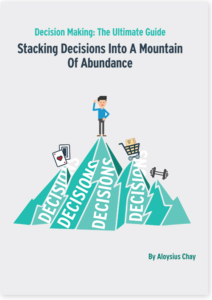INTRODUCTION :
Decision Making : The Ultimate Guide
STACKING DECISIONS INTO
A MOUNTAIN OF ABUNDANCE
INTRODUCTION :
Decision Making : The Ultimate Guide
STACKING DECISIONS INTO A MOUNTAIN OF ABUNDANCE

Think about the times you spent hovering over a single decision.
The times you made a decision and looked back in doubt shortly after.
The times you wished you had an expert to nudge you in the right direction.
Though you can’t always have someone to tell you what to do, you can create a framework to improve the quality of your decisions and increase the likelihood of making optimal ones.
Today, I’ll show you how.
Do you ever wonder how the most successful people have so much ease and confidence in their decisions?
Do you ever wonder how the most successful people have so much ease and confidence in their decisions?
When they say “We should do option A because of X and Y etc”, it seems straightforward and makes perfect sense.
Yet, when you try to make a similar decision, you find yourself clouded by emotions and end up making one in haste. That often leaves you uncertain of whether you made the right judgement at that point of time.
What’s more – if results turn out negative, it can be especially frustrating and discouraging. When this happens, you tend to downplay all of these to your incompetency or dismiss it as that “I’m just not as good as them”.
The truth is, you’re more than capable of making optimal decisions.
All of us want to be able to make decisions that we ultimately do not end up regretting. In order to improve the quality of your decisions to avoid all unnecessary post-decision trauma, what you need is a proven framework as well as an understanding on how we make decisions.
That’s exactly what I have for you in this free guide: a proven system to eradicate poor decisions and make optimal ones that has helped me to get to the top of the professional poker food chain, build a multimillion-dollar e-commerce business and live a rich life. Even more essentially, it has helped me work through the millions of possibilities out there to work on the biggest goals in life.
Are you ready to compound the best decisions and achieve your goals with certainty?
Let’s get started.

Don’t have time to read the whole habits guide right now?
No worries. Let me send you the full 35-page guide as a PDF so you can read it when it’s convenient for you. Just let me know where to send it (takes 5 seconds):
INTRODUCTION :
Ultimate Guide to Decision Making Part 2:
Why I Wrote This Guide
INTRODUCTION :
Ultimate Guide to Decision Making Part 2:
Why I Wrote This Guide
Just 5 years ago, I completed my mandatory conscription in the Singapore Armed Forces and was playing poker recreationally. While I was making decent money for an undergrad, I was not fully convinced that it could be a possible career choice. Let me explain why.
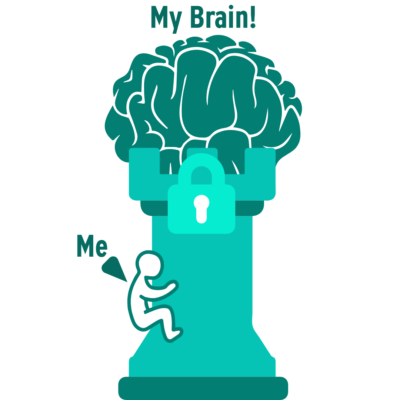
In Singapore, it is a social norm for young adults of my generation to obtain a Bachelor’s degree before moving on to a 9-to-5 job. Naturally, I enrolled in University to pursue Economics. However, I felt the classes were a waste of time. Moreover, my short gambling stints in Macau (Chinese Sin City) were making me more money than I could possibly ever make at a 9-to-5 job with the degree I can get.
Shortly after, one of my trusted buddies persuaded me to quit school and pursue poker full-time. Perhaps it was due to societal norms or inertia on my part, but dropping out of school had never occurred to me before then.
Nonetheless, I’m glad I made that decision – it eventually led me to playing the highest regularly played stakes poker in Macau, making over 7 figures in winnings.
That got me thinking – what if nobody had pushed me to quit school & pursue poker?
My life would be radically different now!
I might be slogging away doing desk work at a bank, for a boss that I hate, for the life that could be better.
I then realized that I left a lot of my other decisions to chance and blaming it on ‘lack of expertise or experience’
What if I told you – even the smallest and seemingly insignificant decisions can slowly affect how our lives pan out?
As illustrated in the graph below, making a small error or two may cause a minuscule effect on our lives in the short term. However, the power of compounding tells us that anything repeated over time ultimately creates a compounded result. This means that as time goes by, even the simplest error would compound to greatly affect where we stand in life. This is especially the case when we extrapolate to a longer period of time!
Let’s say that you’ve chosen to eat at McDonald’s over a clean and healthy meal. It may not affect you if you do that today. However, if you continue doing that consistently, it’s going to reflect on your health (and waistline).
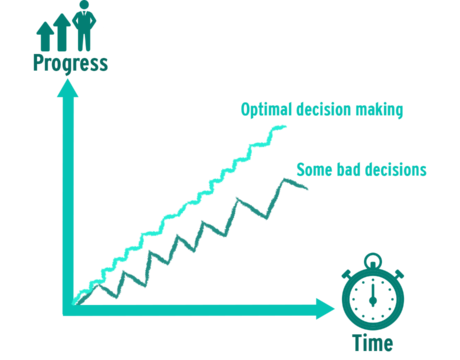
With this newfound revelation, I starting building a framework for making better decisions. I use the exact same framework to make key decisions in my businesses, ad hoc travel plans and virtually everything that requires decision making – and that has allowed me to sleep soundly knowing I have done what I could to the best of my abilities.
If you feel that you still make poor decisions once in a while or are still puzzled at how certain people consistently make good decisions with ease, don’t worry.
I felt exactly the same years ago.
The best time to start was yesterday, the next best time to start is today. - R.A.Lafferty
With the systems, frameworks and strategies laid out in this free guide, you can easily change that.
You can learn how to master the tools and framework to making better decisions, for life.
Once you get a hang of making better decisions, you virtually guarantee a better future for yourself – stacking great decisions from this moment forward.

Who am I?
Hey, I’m Aloysius Chay, an eCommerce entrepreneur. I share content to help you build your business, work less hours and compound on the simplest yet finer things so that you can build a Rich Life too.

Who am I?
Hey, I’m Aloysius Chay, an eCommerce entrepreneur. I share content to help you build your business, work less hours and compound on the simplest yet finer things so that you can build a Rich Life too.
In this guide you’ll learn:
In this guide you’ll learn:
Latticework of Mental Models
Why were we taught physics, maths and all the other seemingly useless subjects back in high school? As it turns out, these mental models that we were taught are critical in shaping our decision making skills. In Part 3, I will outline the most important mental models that carry the most freight in decision making across multiple disciplines.
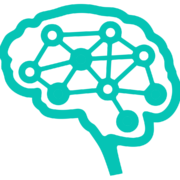
Latticework of Mental Models
Why were we taught physics, maths and all the other seemingly useless subjects back in high school? As it turns out, these mental models that we were taught are critical in shaping our decision making skills. In Part 3, I will outline the most important mental models that carry the most freight in decision making across multiple disciplines.
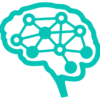
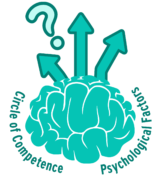
The 2 Step Decision Making Process
With thousands of decisions to make in any given day, it’s crucial that we don’t complicate things further with tedious processes to make decisions. In Part 4, I will explain Charlie Munger’s 2-step decision making process.

The 2 Step Decision Making Process
With thousands of decisions to make in any given day, it’s crucial that we don’t complicate things further with tedious processes to make decisions. In Part 4, I will explain Charlie Munger’s 2-step decision making process.
How to automate the easiest decisions, Zuckerberg style.
Ever wondered why Mark Zuckerberg, CEO of Facebook, always wears the same outfit wherever he goes? This is to eliminate decision fatigue. In Part 5, I’ll teach you the best way to automate the easiest decisions in your day-to-day life.
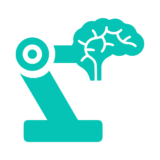
How to automate the easiest decisions, Zuckerberg style.
Ever wondered why Mark Zuckerberg, CEO of Facebook, always wears the same outfit wherever he goes? This is to eliminate decision fatigue. In Part 5, I’ll teach you the best way to automate the easiest decisions in your day-to-day life.


Using decision making to live a rich life.
In Part 6, I’ll talk about the importance of direction and the final question to living the life you desire.

Using decision making to live a rich life.
In Part 6, I’ll talk about the importance of direction and the final question to living the life you desire.
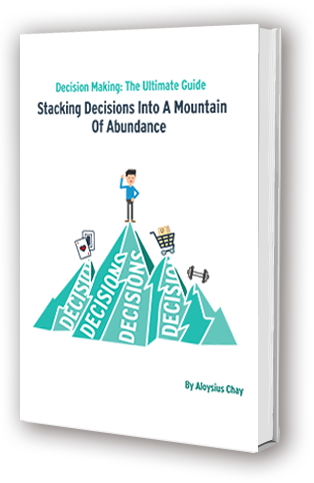
Don’t have time to read the whole habits guide right now?
No worries. Let me send you the full 35-page guide as a PDF so you can read it when it’s convenient for you. Just let me know where to send it (takes 5 seconds):
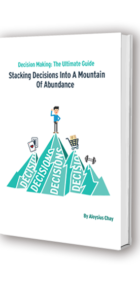
Don’t have time to read the whole habits guide right now?
No worries. Let me send you the full 35-page guide as a PDF so you can read it when it’s convenient for you. Just let me know where to send it (takes 5 seconds):
Ultimate Guide to Decision Making Part 3 :
Latticework of Mental Models
Ultimate Guide to Decision Making Part 3 :
Latticework of Mental Models

I used to have huge doubts in the education system as to why we spend so many years learning elementary math, science and so forth. They don’t seem to be relevant in our current work… or are they?
As it turns out, mental models help us understand life. They explain how things work and can be applied to any concept, simplified complexity or worldview.
Simply put, mental models help us think better. Treat them like tools. The more tools you collect in your toolbox, the likelier it is for you to make better decisions. Some of them we learnt during our formal education and some of them we learnt along the way through books and such.
The world is too complicated for us to process. We deal with millions of micro information through our senses every moment.
What happens when we can’t process them all? We end up taking shortcuts to simplify them which lead to mistakes.
It’s easy to make wrong decisions and mistakes when it comes to things we don’t understand.
You might bust your life savings co-investing in a bar on Brooklyn Street off Uncle Tony’s recommendation. You might say something you don’t mean and ruin your relationship with your potential spouse.
Keeping these mental models at our fingertips allows us to view the world more rationally by guiding our perception and behavior. This will in turn help us to avoid making unnecessary mistakes and rash decisions.
It’s no wonder billionaire investor Charlie Munger refers to mental models as the key to “elementary, worldly wisdom”.
80 or 90 important models will carry about 90% of the freight in making you a worldly-wise person. And of those, only a mere handful really carry very heavy freight. - Charlie Munger
There are thousands of mental models, but the most important ones we should tackle are the ones that apply broadly across multiple disciplines and are applicable to a wide spectrum of situations.
Concepts that we learn in school, for instance Bell Curve / Normal Distribution / Velocity – they’re all mental models. In fact, we have been picking up mental models and internalizing them throughout the years. Our days spent in the classroom are not for nothing!
However, most of us limit our perceptions to our specialization in our work. Instead of employing a latticework of mental models to make decisions, most of us may only make use of the few from our disciplines. Take a look at this illustration below.
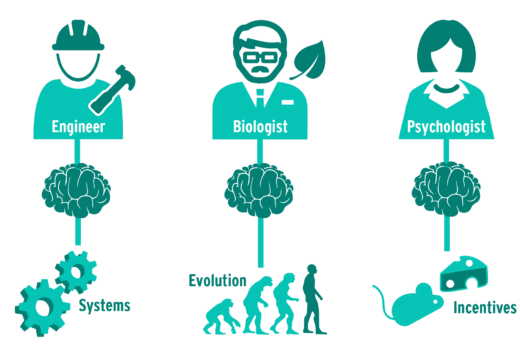
If we look at things only in a certain perspective, we’ve got a blind spot. And blind spots can kill you. It’s like the old saying, “To the man with only a hammer, every problem looks like a nail.” Our goal is to put these thinking disciplines together and look at problems in a three-dimensional way. This will then allow us to make better decisions on a regular basis.
You’ve got to hang experience on a latticework of models in your head - Charlie Munger
I’m going to make it easy and actionable for you guys here. I’ve narrowed down the never-ending list of mental models down to those that carry the heavier freight in our decision making and are applicable across multiple disciplines.
Now you probably would have seen a lot of these mental models throughout your life. I won’t be explaining their meaning to you but instead I’ll be giving examples off a fictitious character called Annie. For those mental models that are foreign to you please look them up online.
Let’s get on to it.
List of Mental Models
General Thinking Concepts
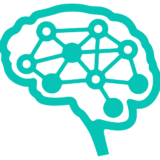
-
The Map is not the Territory – Don’t use a picture to tell you how beautiful the Antarctic is, it’s just a reduction of what it truly is. Not only that, it may not be real-time.
-
Inversion – Your uncle hands over his bar to you and you have no idea on how to run awesome bars. It’s easier to avoid doing things that will make it fail than to do things that can make it a great success.
-
Backward Rationalizing – Annie slammed the table when she saw the lights were left on the whole night because Johnny didn’t switch them off before bed. Remind Johnny to switch off lights or else we’re gonna hear from Annie again.
-
Circle of Competence – Annie is good at bowling. Annie understands that even though it may seem like a ball sport, it does not mean she can be good at basketball, soccer etc. She will not commit or have high expectations in those sports.
-
Occam’s Razor – The bus knocked Annie over because she was using her phone and wearing a flashy rainbow shirt or the bus knocked Annie over because the driver was late into his shift and feeling sleepy?
-
Hanlon’s Razor – Your aunty Margaret wasn’t intending to scam you into that ponzi scheme, she was just oblivious to it.
-
Second-Order Thinking – Annie thinks the solution to accommodating more customers is to place extra tables and seats outside her bakery. Annie, however, did not think of the public space implications of doing that. Annie is not practising second-order thinking here.
Numeracy

-
Permutations and Combinations – If the coin is slightly rigged to 51%, betting on the rigged side constantly will reap a profit in the long run.
-
Algebraic Equivalence – Annie does not know and wants to find out how many cakes did Mary buy today. ( X = Number of cakes Mary bought ) Annie started with 10 cakes and only have 8 left in the fridge. ( X + 8 = 10 ) -> ( X = 10 – 8 = 2 )
-
Randomness – The bird shit landing on Annie’s head today is probably due to chance, not that they hate her.
-
Stochastic Processes – Annie can predict the number of customers in her bakery at each time by observing the rate at which her customers enter and exit.
-
Compounding – 10% interest rate on $1,000 does not just reap you $1,000 extra in 10 years. $1000 X 1.1^10 = $2593.74
-
Multiplying By Zero – You can be the strongest man on earth but without a brain you cannot survive. You will always need one
-
Churn – No matter how loyal Annie customers are, some of them will still switch providers overtime.
-
Law of Large Numbers – If Annie’s average number of customers who choose to buy chocolate cake is 30%, its likelier to see 300 chocolate cakes sold after 1k than 3 chocolate cakes after 10 customers.
-
Bell Curve/ Normal Distribution – Most adults fall between 40-100kg, anything outside of that are outliers
-
Power Laws – Compound interest, pareto principles are all power laws. The most important word in the language takes up 7% of all words used.
-
Regression to the Mean – If you suddenly score a lot of 3 pointers when you generally suck at the game, it means very likely you will regress back to sucking. Don’t mistake noise for signal
-
Order of Magnitude – Is it important to know how far is the other side of the globe to the nearest km or just the nearest 100 km?
Systems

-
Scale – Igniting a firework can be beautiful to watch, scale it up a thousand times and it can be fiery hell.
-
Law of Diminishing Returns – Annie hires more bakers so that her bakery can produce more cakes. As the number of bakers increases, their workloads become smaller. It reaches a point where the number of cakes produced stops increasing as the bakers are slacking off.
-
Pareto Principle – 80% of the world wealth is owned by 20% of the richest people
-
Feedback Loops – When sales are doing well, Annie gives her employees a pay raise. This makes her employees happy, providing better customer service, which increases sales even more.
-
Chaos Dynamics ( Butterfly Effect ) – Difference between leaving the stove on and off can cause in something as big as a neighborhood fire.
-
Preferential Attachment ( Cumulative Advantage ) – Annie always shops at Walmart because of its massive variety. If Johnny wants to start a new supermarket it’s gonna be extremely hard to win Annie over.
-
Emergence – Annie paid no heed to a few ants that she spot in her bakery. Weeks later she noticed a much higher number of ants in the bakery and it turns out that a full blown ant colony emerged at one of the cupboards in the store.
-
Irreducibility – You cannot combine brains of all the basketballers to get Lebron to shoot further or more accurately. You cannot make get many women pregnant to reduce the amount of time needed to have a child.
-
Tragedy of the Commons – If we only use the gym and not upkeep it, eventually the equipments will be broken.
-
Gresham’s Law – Annie would rather choose to be selfish than to be generous, part of her survival instincts.
-
Algorithms – Human DNA contains algorithm for building a human being.
-
Fragility – Robustness – Antifragility – It would take dropping iphone from 2 storey building to destroy it but if u drop it from 1ft high there will be zero damage.
-
Backup Systems/ Redundancy – Make sure you have Plan B or even C even though Plan A seems perfect and nothing can go wrong
-
Margin of Safety – Annie’s customer ordered enough cupcakes for 12 people even though she is only expecting 10 guests. She wants to make sure she has enough in case people bring their +1s.
-
Criticality – Critical mass for water to turn into ice is 0 degrees celsius.
-
Network Effects – The telephone is only as useful if people own telephones
-
Via Negativa – Removing the most mischievous child from the group will be more effective than punishing the whole group
-
The Lindy Effect – Annie will continue to expect to die as time passes but her ideas lifespan will grow as it remains proven.
-
Renormalization Group – Annie gets a cake order for a wedding with 50 guests. She estimates that each of the cakes she usually bakes is for 5 people. While she’s never baked a wedding cake before, she fulfills the order by baking a cake with ten times the amount of ingredients
-
Spring-loading – Buying insurance is a positive spring load against death or unwanted events.
-
Complex Adaptive Systems – Complex and Adaptive are seperate. Annie and her group of friends are adaptive to changes in date plans. The weather is not adaptive to Annie’s prediction of it. The movie can work even without seats in the cinema but without the projector it cannot show. Without the film it cannot show. Thus the projection system is complex.
Physical World

-
Laws of Thermodynamics – Annie’s bakery will not go from messy to clean without her having do any work on it.
-
Reciprocity – Annie gives Johnny a birthday present this year, Johnny is likely to reciprocate and give her a present on her birthday too.
-
Velocity – If you travel at high speed but in circles, you’re never getting anywhere. Whereas for velocity, you get somewhere.
-
Relativity – A fish will never truly understand the fish tank like we can never truly understand the world from our own POV.
-
Activation Energy – It takes a certain amount of energy to light up a fire, but anything before that level would be useless and ineffective
-
Catalysts – Johnny slapping Annie is the catalyst to ending the relationship
-
Leverage – Annie leveraged on Johnny’s strength to open the can.
-
Inertia – It’s hard to get Annie to get off the couch after resting comfortably on it. And it’s hard to get a speeding car to get to an immediate halt.
-
Alloying – A combination of 2 metals can get a stronger metal than expected. A combination of 2 strong individuals may get effects stronger than just 2.
-
Viscosity – Annie has to be careful not to add too much cocoa butter into the chocolate for her chocolate fountain if not risk it not flowing properly being too thick and slow to flow (viscous).
Biological World

-
Incentives – Annie always works out 5 times a week because that’s what been maintaining her devil body.
-
Prisoner’s Dilemma – There’s a fruit bowl which Annie and Johnny can reach into to take fruits. If she takes it together with Johnny. they can take two each. If she takes alone, she can take 3 and John will take none. They are better off taking together but it’s a decision they have to make.
-
Tendency to Minimize Energy Output – Annie is likely to survive longer than someone else who requires twice as much energy to do a same thing.
-
Adaptation – Annie started slouching a lot because the ceiling is very low at her new workplace
-
Evolution by Natural Selection – If Annie does not make unique and innovative cake decorations, she may end up losing customers to competitors who are doing so.
-
The Red Queen Effect (co-evolutionary arms race) – If Annie decides to sit still on her business, she will eventually be phased out as everyone else is moving forward.
-
Replication – Annie is replicated from her mother’s DNA and Annie replicates Johnny’s success to a bakery by following his exact systems and methods
-
Hierarchical and Other Organizing Instincts – Annie tend to look towards her boss for guidance, just as her colleague look to her for guidance as she is a senior at work. As flat as the structure may seem, it is still evident.
-
Self-Preservation Instincts – Annie resorted to killing her colleague in self defense. It came off as shocking as she was extremely religious and would never hurt anyone.
-
Simple Physiological Reward-Seeking – Annie enjoys cake as a reward of a long day of work.
-
Exaptation – Annie bought her computer last year to play games on it. She now uses it to manage her online cake orders.
-
Ecosystems – Annie is part of the community which is an ecosystem.
-
Niches – Annie find that speciality in doing matcha cakes is lucrative in her area so she decided to carve out this particular niche for it.
-
Dunbar’s Number – Annie’s neocortex in her brain only allows for trusting 100-250 other human beings. Other animals have different number.
Human Nature & Judgement

-
Trust – Annie trusts Johnny to look after her bakery as it will be extremely troublesome to keep an eye on it on her own all the time. The rewards of trust are high
-
Bias from Incentives – Annie believes her cakes are the best in the city because of the amount of blood, sweat and tears she puts into baking them. She doesn’t know that other bakers are working extremely hard as well though.
-
Pavlovian Association – Annie hears the bustle of the lunch crowd as a good sign that she’s gonna make sales!
-
Tendency to Feel Envy & Jealousy – As much as Annie practices Buddhism, she still can’t get past feeling envious of the big baking brands out there.
-
Tendency to Distort Due to Liking/Loving or Disliking/Hating – Annie thinks that particular flour brand is the best quality due to their premium packaging but she hasn’t done a proper taste test for it.
-
Denial – Johnny doesn’t know his eating habits is making him obese soon but it’s keeping him out of depression.
-
Availability Heuristic – Annie was able to recall the last time she saw painkillers as it was always placed close to the checkout counter and she saw it repeatedly
-
Failure to Account for Base Rates – Annie lets a child thief in her store go as he says it’s his first time and will never do it again. Is it really his first time or did he just get away with it and will be back again soon?
-
Tendency to Stereotype – Annie thinks the younger generation hardly bakes now and don’t pay as much heed to them when they enter her store.
-
Failure to See False Conjunctions – Mary visits Annie’s bakery 3 out of 5 days. Mary buys chocolate cake 3 out of 5 times that she visits. Annie thinks it’s more likely that Mary visits her store and buy chocolate cake than Mary not visiting her store. However she fail to realize that buying a chocolate cake as a subset results in a much lower overall chance of it happening due to its specificity. ⅗ * ⅗ = 0.36 as opposed to ⅖ = 0.40
-
Social Proof ( Safety in Numbers) – People don’t dare to enter Annie’s store as it looks intimidating with the classy look when there’s no one in it. But whenever it gets crowded, it gets VERY crowded as people get more bold to go in to take a look.
-
Narrative Instinct – Annie likes to think there is a meaning behind her exceptionally bad day at work when it’s just a series of unfortunate events.
-
Curiosity Instinct – It’s in human nature to want to know more about everything
-
Language Instinct – It’s in human nature to learn grammatically construct language as it helps us to create more varying meaning.
-
First-Conclusion Bias – Annie took on the first logical conclusion why her bakery failed and refused to look further into it.
-
Tendency to Overgeneralize from Small Samples – On the first day, most of the sales came during the morning so Annie thought people usually buy from her only during the morning.
-
Relative Satisfaction/Misery Tendencies – Annie was happy to receive a gift from her friend but became angry and jealous when she found out that the same friend gave Johnny a more expensive gift.
-
Commitment & Consistency Bias – Annie told her customers she will give a discount for the coming valentine’s day. Little did she know the discount was so huge that she would make a loss on the sale. However, it’s too late as she wants to keep to her commitment and be consistent with what she says.
-
Hindsight Bias – Annie thinks that she knew it all along that the location of her bakery is bad after a month of poor sales.
-
Sensitivity to Fairness – Annie tries extremely hard to treat all her customers equally even though what is fair is relative and based on one’s perception.
-
Tendency to Overestimate Consistency of Behavior – Johnny has been a well-behaved child through his early teens but that does not mean he won’t change due to situational factors like environment.
-
Influence of Stress – Annie’s sudden increase in the number of cake orders is causing her to be stressed out. However, her good baking habits is making swift work of everything and does not compromise on the quality of the cakes. On the other hand, when she’s performing mentally strenuous tasks, she does badly at them.
-
Survivorship Bias – Trying to replicate what Facebook did or Google did may be right. This was what hundreds of other tech companies did but failed due to their failure to notice and take into account multiple variables.
-
Tendency to Want to Do Something – After Johnny shares his experience about being beaten up, Annie offers advice to Johnny about self defense even though she had no training in it.
-
Falsification/ Confirmation Bias – Annie thinks that sugar is healthy. When the LADBIBLE comes up with an article about how sugar is healthy, she shares the article with everyone to prove her theory.
Microeconomics & Strategy

-
Opportunity Costs – After Annie started her bakery, she no longer has time to explore her IT career. The opportunity costs of her starting a bakery is pursuing a career in IT, of which she could have made much more.
-
Sunk Costs – Annie spent $2000 researching on a new location for another bakery and decided against opening it. The $2000 is a sunk cost that she can never get back.
-
Creative Destruction – All the bakeries in the region are constantly improving their offer or niche to best one another. Annie finds herself slowing down whenever she stops doing it.
-
Comparative Advantage – Annie’s major in health food science gives her a comparative advantage against competitors in baking in understanding ingredients.
-
Specialization ( Pin Factory ) – It’s easier to get Annie’s employees to knead the flour, do piping and clean equipment separately than to have them carry out all the processes. They can do it faster and better, but it may not appeal to them to do only 1 task all the time.
-
Seizing the Middle – Taking up the best spot in town makes Annie’s bakery the most frequented one.
-
Trademarks, Patents and Copyrights – Annie did not get protected for her cake decoration and soon after, many other bakeries are copying her popular design
-
Double-entry Bookkeeping – When Annie sells a cake, both her bakery’s revenue and cash increases.
-
Utility (Marginal, Diminishing, Increasing) – Annie loves eating chocolate cake. However, eating more than 3 slices would cause her to get sick of it.
-
Bottlenecks – Annie’s bakery is able to churn out a lot of cakes but unable to keep up with the long queue as there is only 1 cashiering machine. That’s the bottleneck to the business.
-
Bribery – Sometimes, Annie gives cakes to the law enforcement officers to make sure they don’t report her for the food disposal issue of her store
-
Arbitrage – Annie does not bake brownies but buys them off another bakery further off to sell them at a higher price to earn on this opportunity.
-
Supply and Demand – Annie took the chance to increase the price of her cakes as her competitors went on a long break. People have no choice but to pay higher for her cakes as they have no other options.
-
Scarcity – There are 5 customers waiting in line to buy Annie’s cakes. However, she only has 2 cakes left. Annie increases the price of her cakes such that there are only 2 customers left willing to pay for them at the inflated price.
-
Mr.Market – With financial markets always fluctuating, it’s our duty to take advantage of it.
Military & War
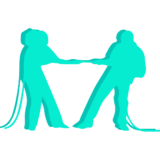
-
Seeing the Front – It’s better for Annie to oversee the entire operations than to rely on someone else.
-
Asymmetric Warfare – Annie uses a different strategy from the big box bakeries as she doesnt have economies of scale.
-
Two-front War – Due to the pest infestation and price war, Annie’s profits are greatly dampened on both ends.
-
Counterinsurgency – Annie hired fake customers to find out who has been sabotaging her bakery.
-
Mutually Assured Destruction – The two biggest bakeries avoid confrontation as it will likely turn into a devastating result for both sides.
It’s easy to get overwhelmed by the sheer amount of mental models out there. It’s just as tempting to just skimp through and read the ones that interest you or give up entirely.
This is why I’ve come up with a comprehensive 5-step plan to help internalize these mental models ASAP.
I’m employing three key strategies for you to internalize these mental models – Spaced repetition learning for memory, ELI5 for understanding and conscious application for internalizing.
Timeline : 3 weeks / 40 hours
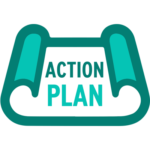
-
Read through the entire list and give an example to explain each mental model such that a five-year-old would understand it.
-
-
You might not be able to do it at the first go but just try your best
-
-
-
This could take easily 20 hours so be prepared for this
-
-
-
Compile your list & explanations in a document
-
-
Come back to it a week later and redo the entire exercise
-
-
This time round, draw an example without referring to the explanation of the mental model
-
-
-
Again, aim to have it as simple as possible so that a five year-old would understand
-
-
Come back to it 2 weeks later and redo the entire exercise
-
Finally, pick out 10 application of mental models in your daily life per day until the end of 3 weeks.
Decision Making : The Ultimate Guide Part 4
The 2 Step Decision Making Process
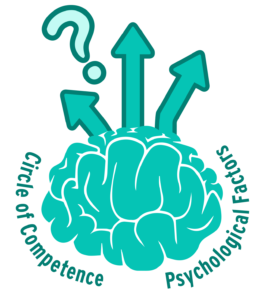
Now that we’ve internalized the latticework of mental models – what’s next?
When it comes to trickier decisions that require more thought, Charlie Munger uses a 2-step decision making process. By using this 2-step filter to make decisions, you can prevent yourself from being manipulated by malicious people or even ignorant well-wishers.
This simple and lightweight approach will help us reduce human misjudgment and make optimal decisions.
Let’s get to it.
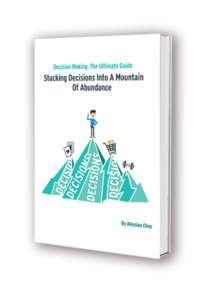
Don’t have time to read the whole habits guide right now?
No worries. Let me send you the full 35-page guide as a PDF so you can read it when it’s convenient for you. Just let me know where to send it (takes 5 seconds):
1) Understand your circle of competence
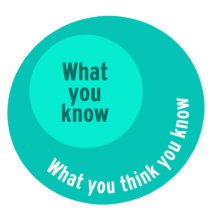
The first step of the approach is to know what you know and know what you don’t know. Are you considered an expert in that field? Which level are you actually at?
Being brutally honest with yourself will allow you to take the extra step to consult people who might give a better insight regarding the issue. If the issue is within your circle of competence, it should not be difficult to work out the relevant variables and forces at play.
However, if the issue is not within your circle of competence and you are forced to make an immediate decision, using inversion as a tool to tackle it could be the way to go.

For instance:
Annie has an important assignment due and she needs to get it done as soon as possible. Instead of trying to apply deep work techniques that she is not familiar in an attempt to increase productivity, it is more plausible for her to avoid doing things that will result in her not getting work done (i.e. getting distracted by social media, going out with friends and so on).
Avoiding stupidity is easier than seeking brilliance. Inverting the issue won’t always solve the problem but it will help to avoid trouble.
2) Understand the Psychological Factors
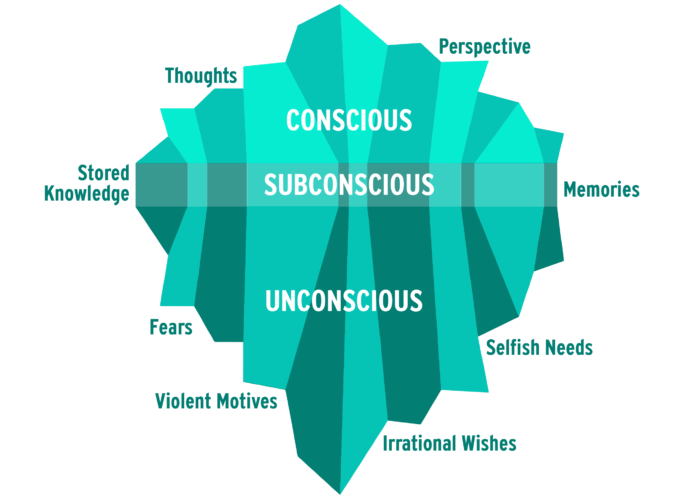
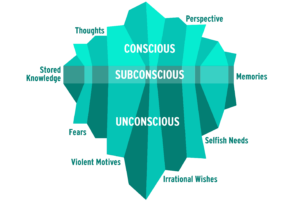
The second step of the approach is to avoid subconscious conclusions that can be devastatingly wrong. Many of us greatly underestimate the power of the unconscious mind. This causes a lot of bias judgement and human tendencies.
If you don’t learn to constantly revise your earlier conclusions, and get better ones.. You’re like a one-legged man in an ass-kicking contest. - Charlie Munger
Apart from internalizing the Human Nature & Judgement section in the List of Mental Models, it’s utterly essential to not be hasty with the important decisions and take the first conclusion as it is.
One exercise is to take a step back and hear different perspectives about it. When you spot biases in other people’s perspectives, you get a better idea if you are having biases yourself.
For instance :
When my rental lease was ending, I was deciding between extending it or finding another location to stay at. My initial thoughts were to weigh the pros and cons of each possible location, in terms of convenience, value for money, potential for growth and so on. However, I still had doubts about my decision despite the in-depth analysis.
Subsequently, I consulted a few friends. One of them mentioned that where I move to next should be a place that is advantageous to achieving my goals. That definitely changed how I think about choosing which place to stay at!
If you watch how people make their decisions closely, you will realize a lot of them are subjected to psychological factors which make their decision making much poorer.
Our goal is be extremely rational and not let our subconscious make decisions for us; or risk being susceptible to the different biases of human nature.
Decision Making : The Ultimate Guide Part 5
Automating the Easy Decisions


I really want to clear my life to make it so that I have to make as few decisions as possible about anything except how to best serve this community. - Mark Zuckerberg
While our dear Mark’s wardrobe can be exceptionally boring, he is right in every other sense. No matter how good you are at decision making, we only have finite willpower that depletes as we use it throughout the day. Automating small day-to-day decisions will free up bandwidth for more important decisions later in the day.
I will first show you how to clear the easy day-to-day decisions that apply to 95% of the population. Next, I will demonstrate how these simple automations may look like in everyday life

Don’t have time to read the whole habits guide right now?
No worries. Let me send you the full 35-page guide as a PDF so you can read it when it’s convenient for you. Just let me know where to send it (takes 5 seconds):
4 Decision Areas for Immediate Automation
1. Organize Your Possessions
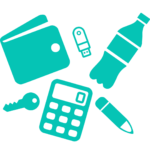
Have a clear idea of where each item goes in your house so you don’t have to decide where to put them and waste your willpower figuring out where they are when you need them.
Take it a step further Marie Kondo style by purging possessions that no longer give you joy. You’ll be surprised by the amount of items that you actually never need to use even in the next 6 months.

-
-
Set aside 4-hour blocks for a few weekends until this is complete
-
-
-
Start with the most unused objects then slowly move to more frequently used ones
-
This will offload decisions regarding where to put things.
2. Standardize Your Outfits

With the number of fashion styles out there, you can never truly keep up with the different and latest fashion trends all the time. Style does not mean a massive walk-in wardrobe; it can mean a one that is clean and versatile too.
If you already have a set uniform to wear to work everyday, that’s awesome because you don’t really have to worry about this section. If not, a great idea would be to engage a personal fashion advisor to simplify your clothing choices.

-
-
Get a wardrobe consultant from Thumbtack to remake your personal style (Cost $25-$120/hour)
-
-
-
Google and find your personal fashion adviser ($80 upwards/hour)
-
The idea is to talk to someone who can figure out the 1-2 styles that suit you best and remake your wardrobe accordingly. That somebody CAN shop for you but you can probably do that yourself as well.
This will offload your decision making when it comes to choosing your outfit for the day.
3. Simplify Your Meals

I can’t count the number of times I’ve stared blankly at food delivery websites, undecided on what to get for lunch/dinner. Similarly, when I’m out to grab a quick bite, I end up engaging in intense mental debate on what to eat (healthy/delicious/refreshing).

-
-
Do meal preparation weekly (Cheapest alternative but will take up a few hours a week)
-
-
-
Hire a personal chef (roughly over $20,000 / annum)
-
-
-
Have pre-made, chef-cooked, healthy meals delivered weekly to your place ($100< / week)
-
Don’t be like me in the past – offload your decision making when it comes to choosing what to eat
4. Declutter The Workspace

Your brain works in such a way that once it registers a certain object, it will trigger a thought about it. If you have 101 items laid out across your workspace/desk you will find yourself constantly engaging in decisions.
“Do I need this pen?”
“Should I throw this wrapper out now or later?”
“When is this credit card bill due?”

-
-
Spend an hour decluttering your workspace.
-
-
-
Think about the things you often have on your workspace. Weigh the trade off between the convenience of reaching out to it quickly vs taking up mental space.)
-
-
-
Remove the things that you use less than once a week.
-
-
-
Next, remove the things that you use less than once daily.
-
-
-
Once you realize it does not even affect you, remove objects that you don’t use hourly.
-
Doing this will offload random decisions that take up mental space so you can focus on your actual work and achieve deep work in the process.
Pro Tip: Don’t forget to declutter your web browser tabs. Having multiple tabs with what seems to be important will leave you with decision fatigue when it comes to finding the right tab for work. This applies to even desktop home screen / phone home screen and more!
Once you have these 4 areas cleared up, congratulations – you are more than halfway through automating the easy decisions in your daily life.
Next, we have to figure out what other specialized areas are causing decision fatigue in our day-to-day lives. This differs for each individual so we need to observe our own habits.

-
-
Start your day as per usual and note down the decisions that take more than 10 seconds to make
-
-
-
Note that you have to be extremely conscious about this in order to identify these decision traps.
-
-
-
Rinse and repeat for the entire week until you have cleared out most of these traps
-
What this might look like in your life:
Example 1:
Back when I was playing live poker in Macau, I traveled to the casino daily. Right before I leave the house, I found myself spending up to a few minutes deciding on a transport option to take. I had three choices – bus, taxi and foot.
Taking the taxi might have seemed like the fastest option. However, it was also erratic and it could be difficult to flag one down at certain times. The buses had a regular schedule, but missing one and having to wait for the next was a big pain in the ass. That left me with going by foot. Although that seemed like the slowest option of the three, it was, however, the most consistent one. There were neither peak hour woes nor the stress of chasing after a bus. As soon as I left the house, I would put on a podcast and walk to the casino in the expected duration.
Example 2:
When I first moved out to live on my own, I found myself catapulted into adulthood and having to deal with bills, bills and more bills. For the first few months, I would freeze up whenever I see a bill slip lying on the table. What is this bill for? When is it due? Have I paid for it already?
One day, while I was on a flight to Bangkok for an e-commerce convention, it struck me that I had forgotten to pay one of my bills. It was then that I realized the sheer amount of unnecessary stress that these payments were causing me.
Upon my return home, I sat down in front of a table and gathered all the bills that I have to pay on a monthly basis. One after another, I applied for them to be paid automatically. This tedious process took a few hours, but boy, was it worth it. How I wish I had done this earlier! I no longer have to worry about managing my bills when I’m out of the country (and skiing down a mountain in Niseko).
As these tiny automations add up each day, it won’t be long before you’ve extended your willpower to make better decisions throughout your day.
Automating your easy decisions will free up mental bandwidth for the more important decisions during the day.
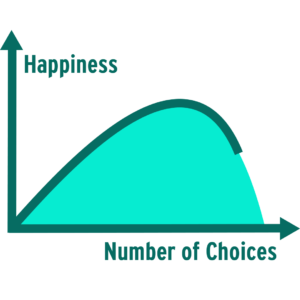
Don’t expect instant change. The above action steps I’ve listed out will take about a month to execute, or a week if you’re fast enough. Execution is key here so do not hesitate and stay accountable for them!
Decision Making : The Ultimate Guide Part 6
Using Decision Making to Live a Rich Life
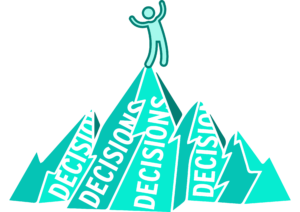
By now, you’d have learnt some of the key systems and strategies to optimal decision making.
Now, it’s time to apply what you’ve learnt to living a Richer Life.
-
In Part 1, we learnt the importance of having systems and framework for decision making.
-
In Part 2, we learnt how the power of compounding good decisions will affect greatly where we stand in life in the long run.
-
In Part 3, we explored the latticework of mental models and how they help shape our decision making skills through different disciplines.
-
In Part 4, we learnt how to use the 2-step decision process in making heavier decisions.
-
In Part 5, we learnt how to automate easy decisions to free up bandwidth for the more important ones.
These skills that you’ve acquired will point you in the direction that you choose your life to be – rich, fulfilling, filled with joy & so on.
You can work extremely hard, but if you’re pointed at the wrong direction, you won’t get far. On the other hand, if you’re locked on your desired destination, no matter how slow you go, you will reach your goal eventually.
Take a little time to think about where you want to be. Once you’ve determined the route to take, stay on course. You may not move forward all the time but if you trust the process, you’ll find yourself getting closer to your goal.
Throughout the years, I’ve shared these systems and strategies of decision making with many of my close friends and loved ones. I’ve seen firsthand how they have benefited from it and are now flourishing in their respective fields – this just goes to show how anyone, no matter how old you are or which industry you’re in, can benefit from learning how to make better decisions.
I encourage you to share this guide with your friends and family and reap the rewards of intelligent decision making together!
The best thing a human being can do is to help another human being know more. - Charlie Munger
References :
Farnam Street. (2019). Mental Models: The Best Way to Make Intelligent Decisions (109 Models Explained). [online] Available at: https://fs.blog/mental-models/ [Accessed 16 Feb. 2019].
James Clear. (2019). Mental Models: Learn How to Think Better and Gain a Mental Edge. [online] Available at: https://jamesclear.com/mental-models [Accessed 16 Feb. 2019].
Mark Zuckerberg icon adapted from: https://jacobgreif.com/funny-or-dies-the-occasional



